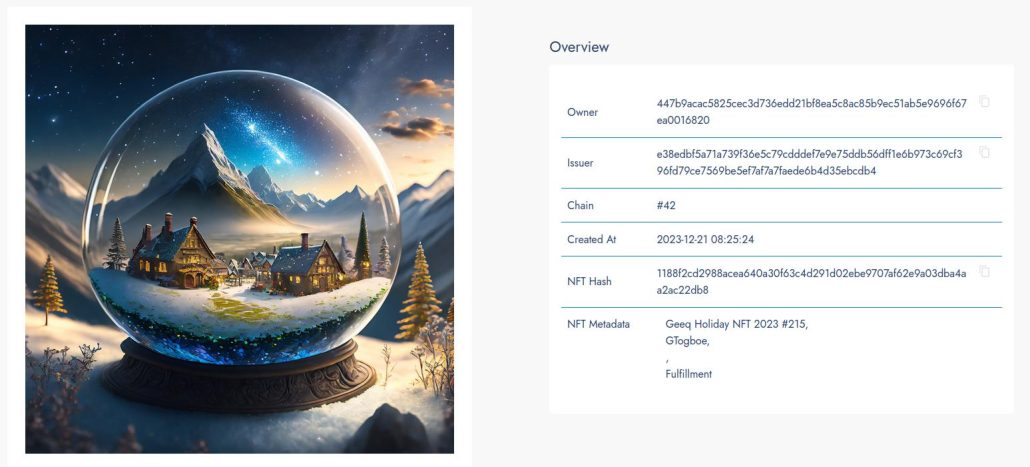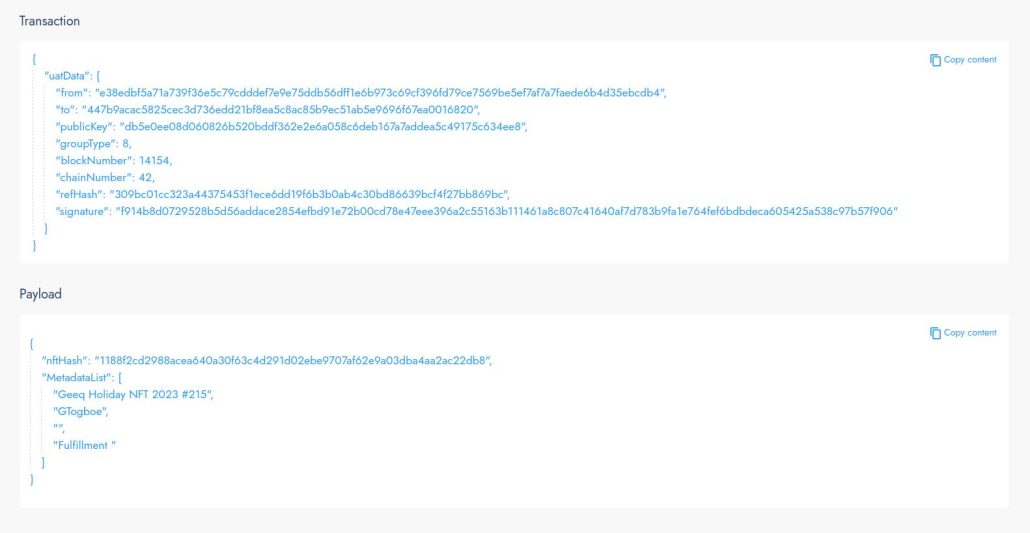By: Geeq on Jan 15, 2024
- Private blockchain v5.2 with white-label NFT mints released for community event
- Holiday app: minted NFT greeting cards with customizable messages
- Block explorer app: showcased two new NFT-specific pages
- Block explorer included user-friendly ‘under the hood’ results for NFT mint transactions
In December 2023, the dev team showcased the ease, efficiency, and flexibility of Geeq’s white-label NFT mints.
Major milestone achieved
Geeq’s development team finished standardizing the process of minting Geeq-native NFTs. The process is simple, efficient, and user-friendly. Using Geeq’s white label NFT mints, any unique asset may be tokenized securely on-chain without using smart contracts.
Geeq NFTs are tailor-made to prove provenance and data lineage for use cases such as supply chain, ownership and transfers of assets, chain-of-custody and attribution of liability.
The v5.2 release was a private instance of a Geeq blockchain, with the enhanced ability to mint and transfer NFTs to a receiving account. The logic was described in last month’s technical update.
The value of pairing blockchains and ordinary apps is apparent
The team wanted to mint greeting cards as NFTs to celebrate our success with the Geeq community. Choosing the application also demonstrated how intuitive and fun the user experience can be when an app is paired with a blockchain back-end.
Enterprises and businesses may customize their minting and block explorer apps with their own branding, UI/UX, and tailor these for the specific users they have in mind. All they will need are the Geeq APIs.
While not front and center, the tech is there
The team modified the previous block explorer app and built an API to showcase two new NFT-specific pages.
Geeq NFTs are pre-formatted for:
- automatic display in a list of an account’s assets
- queries via a block explorer app for NFT metadata, unique ID, issuer, and more
The designs for the NFT asset page and the NFT transaction page are shown and explained below.
The NFT asset page in the holiday block explorer

For the holiday event, the Geeq team chose to store the images in a centrally controlled database so it had access to the images to display. However, this was an implementation choice made for convenience rather than a protocol decision. In practice, a customer may choose to store the image, file, or data in a private database with their own permissions, make those data visible to its consumers only, or make all the data visible to the public.
Geeq is architected so customers have flexibility over their own ecosystems to choose the apps and storage solutions that best work for them. Geeq’s own protocols are data-agnostic and storage-agnostic.
All the data required to validate, mint, and prove ownership of the asset on-chain are contained in the transactions and records when the user provides the app with data to be sent to the blockchain through the Geeq API. These are serious hurdles for other blockchains.
The NFT mint transaction page in the holiday block explorer

Messages containing attestations are not assigned a unique ID. Attestations are data, not assets. For example, if a device attests to the same reading repeatedly (e.g. temperature in a crate), only the pattern of data over time or an anomalous piece of data may matter.
In contrast, when a NFT is minted, it is an asset described by its data. It continues to exist over time and its status may be updated in a ledger. NFTs are useful when the issuer, owners, and transfers must be identified in exactly one account at any given time (unless it is retired, also known as “burned”). The chain recognizes that asset via its unique NFT ID.
There may be times when the asset on-chain represents a physical asset (e.g. a car) or a real world asset (RWA). The reason to give it a NFT ID is to do a deeper dive into who controls the ownership or actions of that device, and how that ownership changes over time.
An under-the-hood look at the protocol: minting a NFT
As usual, the team included the readout of the transaction at the bottom of the transaction page for the technically curious:

Notice the validated data payload is separated. It is written to the simultaneously constructed application layer ledger (ALL) and contains
- The nftHash = the hash of the object to be tokenized and
- Metadata = the description, tags, or labels for the NFT.
These were chosen and provided by the community member who minted the NFT. In this case, the metadata is in clear text so searches in the block explorer were straightforward.
If privacy had been desired, the metadata could have been encrypted so only the receiver (or other authorized readers who are able to decrypt the message) could identify the NFT with something they know.
Because the payload was signed by the minter, the aspects of the NFT record may not be misrepresented without detection. All the information needed to prove its authenticity is in the mint transaction data. Proofs of authenticity and subsequent ownership are easy to calculate and efficient to store.
The standard format of these messages makes it easy to compare NFTs at a glance.
The Geeq difference
Security
Geeq has standardized the minting process for NFTs. These NFTs benefit from Geeq’s maximum security which offers the next generation of blockchain security. The security and proof methods offered by other blockchains, public or private, cannot compare. As the blockchain market matures, we believe users will demand security as well as hard proof their assets exist on-chain and belong to them.
Data availability
Geeq’s protocol is the only method that splits the payload (e.g. description of the asset) from the validated transactions and constructs parallel validation and application blockchains. Notably, all the data required for proof of data provenance and ownership exists on the more compact validation layer, while the details of the NFT records themselves are protected on the application layer.
Efficiency, provability, security, and a back end for the full spectrum of apps
This year, the team achieved its goal of developing, testing, and releasing a standard process to mint NFTs without smart contracts. The extension was possible by building out Geeq’s structure, data availability, and protocol for validation. User-defined unique assets of any kind may be minted as Geeq-native NFTs with efficiency and ease. Security for the user is provable: each valid transaction is backed up by a calculation of a durable merkle proof in real time.
We are thrilled with these accomplishments. They distinguish us from every other blockchain platform. Tremendous progress was made to establish the foundations for secure tokenization and attestations of data where consumers previously had to trust account information and data provided from third parties without proof or recourse.
Geeq continues to work toward improving market efficiency by building technology where trust must be earned at a granular level, so every individual customer enjoys the highest degree of security, no matter who they are.
Thank you for reading, Happy New Year and, as always, thank you for your support!
The Geeq Team






To learn more about Geeq, follow us and join the conversation.
@GeeqOfficial